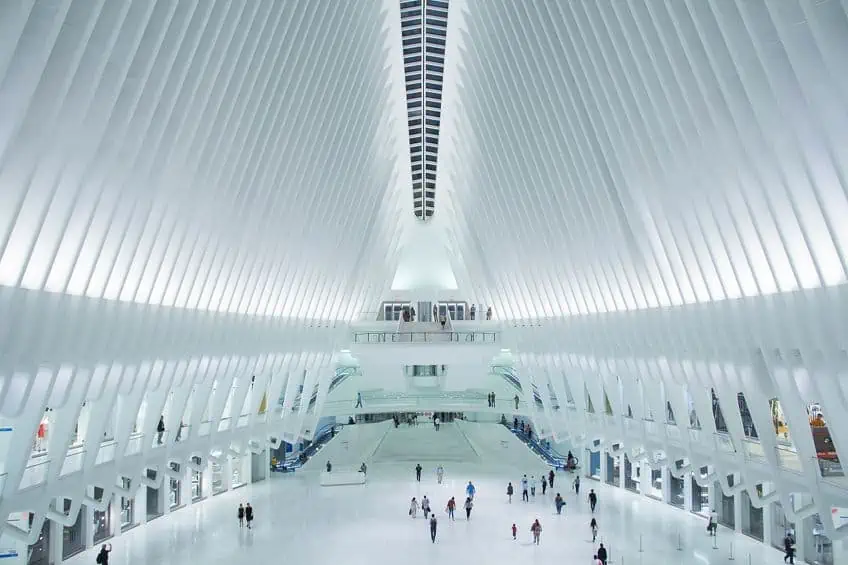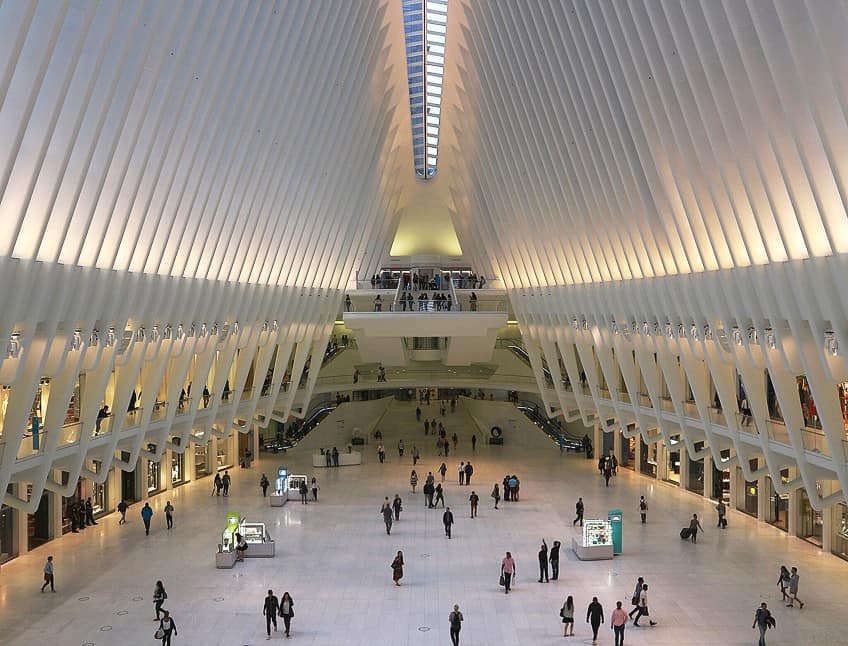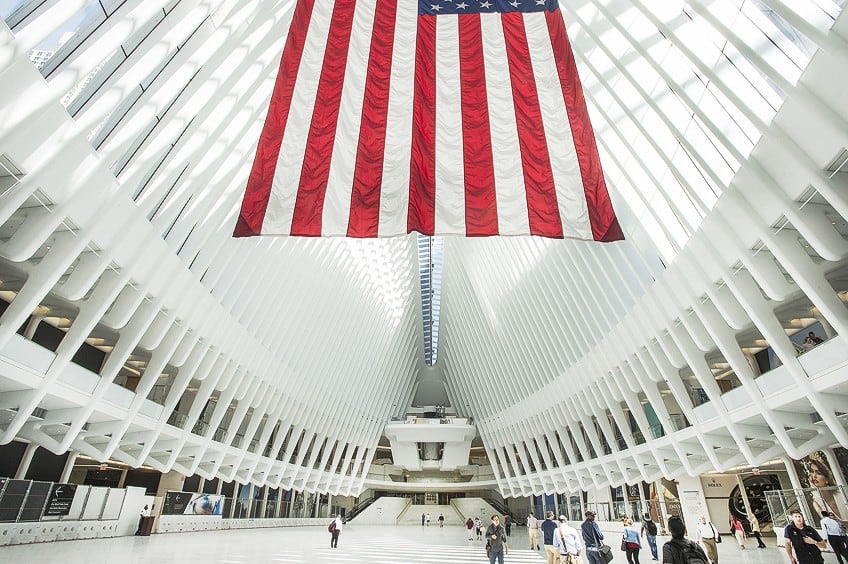Oculus Center in New York – The World Trade Center Station
The Oculus Center in New York City is a magnificent train station terminal located in the Big Apple. The Oculus Building was planned and constructed in the aftermath of the 2001 terror attacks that left the area around the World Trade Center severely damaged, and it was made to replace the original terminal located in this area. In this article, we will examine the Oculus World Trade Center building with regard to its history, architecture, and the Oculus World Trade Center architects who designed it in the first place. Keep reading to learn more about the Oculus Center in New York City!
A Look at the Oculus Center in New York City
| Architect | Santiago Calatrava (1951 – Present) |
| Date Constructed | 2008 – 2016 |
| Function | Train station |
| Materials Used | Steel, glass, and marble |
| Location | Manhattan, New York City, United States |
The Oculus Center is the main station house of the World Trade Center Station in New York City. This is the primary part of the World Trade Center Transportation Hub and a part of the larger World Trade Center complex region. This is one of the busiest locations within the New York subway system that runs throughout the city, and it was constructed following the 9/11 terror attacks that destroyed the original World Trade Center and much of the surrounding area, including part of the World Trade Center station.

However, the Oculus Center in New York City does not actually hold this name anymore in a technical sense as it was renamed to the World Trade Center Transportation Hub. However, it is still known as the Oculus Building to some, and as the Oculus Center. Throughout this article, we too will refer to it by this older name.
The History of the Oculus Center in New York City
The Oculus Center in New York City is located near the original 1909 terminal which was damaged during the 9/11 terror attacks. The original terminal was known as the Hudson Terminal, and it was actually part of a 1960s redevelopment that led to it becoming known as the PATH system. However, when the terror attacks occurred, a new and temporary station needed to be opened and operated while a proper replacement was constructed.
While the 9/11 terrorist attacks occurred in 2001, construction only actually started in 2008 on what would become the Oculus Center.
This new center was designed by Santiago Calatrava as something far more modern than what had existed before, and after $4 billion worth of construction, the structure was finally completed in 2016. The construction of the World Trade Center Transportation Hub as a whole itself took place over several stages, and the Oculus Building served as only one of those phases.

Upon completion of the main terminal building, the Oculus architecture was generally praised and has been considered a stunning sight in the city, but the fact that the building was extensively delayed and cost a significant amount of money led to a number of mixed reviews for this new terminal building, mixed reviews that are quite understandable given that it took 15 years to construct a replacement station for what had been destroyed.
Once the Oculus World Trade Center terminal was in operation, it was immediately considered to be one of the most expensive train stations in the world (or even as the most expensive train station in the world).
However, it was, at last, open to the public and could be used. However, the project of the Oculus Center in New York City as a whole was not quite solely for the purpose of creating a new train station. This new Oculus World Trade Center had several purposes. The main stated goal was to introduce a replacement for what had been destroyed, but it was also meant to be a rival to the other incredibly busy and stunning stations in New York, like Grand Central Terminal and Penn Station. Furthermore, it was meant to be part of a larger reconstruction and revitalization effort for the World Trade Center region in general.

For this reason, the Oculus Center in New York City includes various locations for shopping and dining, and it easily connects with various other attractions in the region. This has aided in rejuvenating this part of the city, and it has remained one of the most stunning terminals in the city and also one of the busiest.
The Architecture of the Oculus Center in New York City
The Oculus Center in New York City is considered to be one of the most stunning contemporary structures in a city already known for its architecture. The Oculus architecture is made up of curved rib structures made of steel that produce a triangular interior with an immensely tall height for a train terminal.
This immensely distinctive design is meant to be evocative of a child releasing a bird from their hands.
The design could also be seen as a large pair of wings or ribs, and these large steel beams are designed to curve slightly to create the well-lit interior of the terminal. This well-lit design is thanks to the massive panes of glass that are held aloft by the steel beams, and the white paint that coats the steel beams adds to this light-oriented aesthetic. One of the other important aspects of the design is that the roof makes use of a skylight that opens on sunny days, and this only adds to the vast amount of natural light that is able to pour into the terminal. Furthermore, the skylight also opens every year on 11 September in commemoration of the 9/11 terror attacks.

The skylight is also the reason for the name, as an oculus is the eye of a building, and this skylight is particularly lengthy. While the oculus of a building was fairly common in domed structures, as there would often be a central opening, it is not a strictly necessary feature any longer as artificial lighting now exists.
Lastly, the Oculus Center in New York City also includes a marble floor that gives the spacious interior an elegant appearance.
It is also used as a means of juxtaposing against the dark granite that is used in the 9/11 Memorial and Museum that is near the Oculus Building. All of these elements together produce a train terminal unlike anything else that has ever been designed, and it is a stunning example of architecture oriented around the use and allowance of natural light. The design is somewhat strange and peculiar, but it has become one of the most notable contemporary sights in New York City.
The Architect of the Oculus Center in New York City
The new Oculus Center in New York City needed to be designed by someone, and it had to be someone good because this was the World Trade Center. Architects from around the world needed to be screened to determine who would be best for the job, and it ultimately landed on one of the premier architects of the contemporary era, Santiago Calatrava.
Santiago Calatrava is one of the most famous and successful architects currently working, and he has become particularly known for many of his more organic and expressionistic designs. He does not consider himself particularly beholden to any formal architectural style, and his work is instead aimed at reflecting something about the structure and region.
This is why, for the Oculus Center in New York City, Calatrava was inspired by the image of a child releasing a bird from their hands, and this led to the ribbed design that has now become so famous throughout the city. His many other designs around the world have been similarly individualized to what the project itself needed. Some of his most famous works include the Turning Torso in Malmö, the Auditorio de Tenerife in Santa Cruz de Tenerife, and the Alamillo Bridge in Seville. His work can be found around the world and is often identified through the extravagance of its design, the unusual materials that are used, and the immense cost of what is constructed.

These are also some of the reasons that his work has been criticized in recent years. The projects that he works on have a tendency to balloon in terms of their budget, and these are not the only criticisms that he has faced. He has also designed structures without seemingly adding certain accessibility features, such as the lack of elevators in the City of Arts and Sciences in Valencia, where the opera house was simply inaccessible to some people.
Additionally, he has designed structures with materials that were not particularly suited to the job, such as a gorgeous bridge in Balboa that made use of glass tiles.
The bridge was stunning and so were the tiles, but they didn’t account for rain, and so whenever they became wet, they caused injuries. This forced the addition of anti-slip materials that cost extra. Furthermore, he has designed landscaped garden architecture that made use of metal that heated in the sun and literally baked the plants that were meant to grow over it. These criticisms point towards a tendency towards trying something new without necessarily considering what could happen because of those decisions, and several of these issues have even been litigated in court. However, regardless of these criticisms, Santiago Calatrava is considered to be one of the most notable architects in modern history, and his work on the Oculus Center in New York City has been, generally, praised.
And that is what we have to say about the Oculus Center in New York City. This is a stunning piece of contemporary architecture located in the Big Apple. This article examined the Oculus architecture, its brief history, and the architect in charge of the design. Hopefully, you have learned a good deal about this now-famous train station in New York, but there are also many other stations worth exploring!
Frequently Asked Questions
What Is the Oculus Center in New York City?
The Oculus Building, also known as the World Trade Center Station, is both a central train terminal in the city, but also part of a larger rejuvenation project for the region. As such, the Oculus Center in New York City includes various shops and restaurants alongside its existence as a train terminal. It was specifically constructed to replace the old train terminal that had been extensively damaged in the 9/11 terror attacks.
What Is the Architectural Style of the Oculus Center?
The Oculus Center in New York City is not a particularly traditional structure in its general design, and as such, it does not necessarily conform to any one architectural style. Instead, it makes use of a variety of styles, but it can be seen as a form of organic architecture because of its more natural shape, or it could be seen as a form of expressionist architecture because it is meant to be symbolic of new beginnings, or it could even be seen as a form of structuralist architecture because of its focus on being a feat of engineering prowess.
Who Designed the Oculus Center in New York City?
The Oculus Building was designed by the famed Spanish architect, Santiago Calatrava. This contemporary figure is one of the most successful architects to have ever lived, and his work is typically non-classifiable in terms of architectural styles. His work is decidedly contemporary, but often blends aspects of organic and expressionistic styles together to produce something strange and unique.
What Is the Oculus Center in New York City Used For?
The Oculus Building is, principally, used as a central train terminal, but it is also a larger rejuvenation project that is made up of various shops and restaurants. Additionally, it has been used for various events, such as art exhibitions. As it is part of the broader World Trade Center region and reconstruction project, it is meant to serve as a location to bring the general area back to its former glory following the devastating 2001 terror attack that rocked the city, as well as the world.
Why Was the Oculus Center in New York City Built?
The main reason that the Oculus Building was constructed was as a replacement for the previous terminal that had been destroyed in the same location, but it was also meant to be part of a larger project to rejuvenate the general World Trade Center region in the city. The area had been utterly devastated in the wake of the attacks, and so there needed to be new structures built to replace and improve on what had been destroyed.
Justin van Huyssteen is a writer, academic, and educator from Cape Town, South Africa. He holds a master’s degree in Theory of Literature. His primary focus in this field is the analysis of artistic objects through a number of theoretical lenses. His predominant theoretical areas of interest include narratology and critical theory in general, with a particular focus on animal studies. Other than academia, he is a novelist, game reviewer, and freelance writer. Justin’s preferred architectural movements include the more modern and postmodern types of architecture, such as Bauhaus, Art Nouveau, Art Deco, Brutalist, and Futurist varieties like sustainable architecture. Justin is working for artfilemagazine as an author and content writer since 2022. He is responsible for all blog posts about architecture.
Learn more about Justin van Huyssteen and about us.
Cite this Article
Justin, van Huyssteen, “Oculus Center in New York – The World Trade Center Station.” artfilemagazine – Your Online Art Source. June 29, 2023. URL: https://artfilemagazine.com/oculus-center-in-new-york/
van Huyssteen, J. (2023, 29 June). Oculus Center in New York – The World Trade Center Station. artfilemagazine – Your Online Art Source. https://artfilemagazine.com/oculus-center-in-new-york/
van Huyssteen, Justin. “Oculus Center in New York – The World Trade Center Station.” artfilemagazine – Your Online Art Source, June 29, 2023. https://artfilemagazine.com/oculus-center-in-new-york/.



